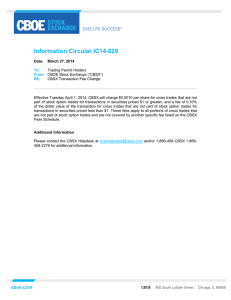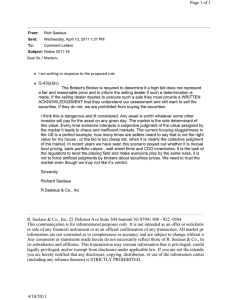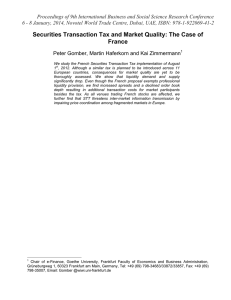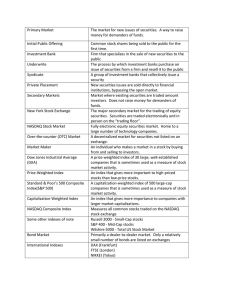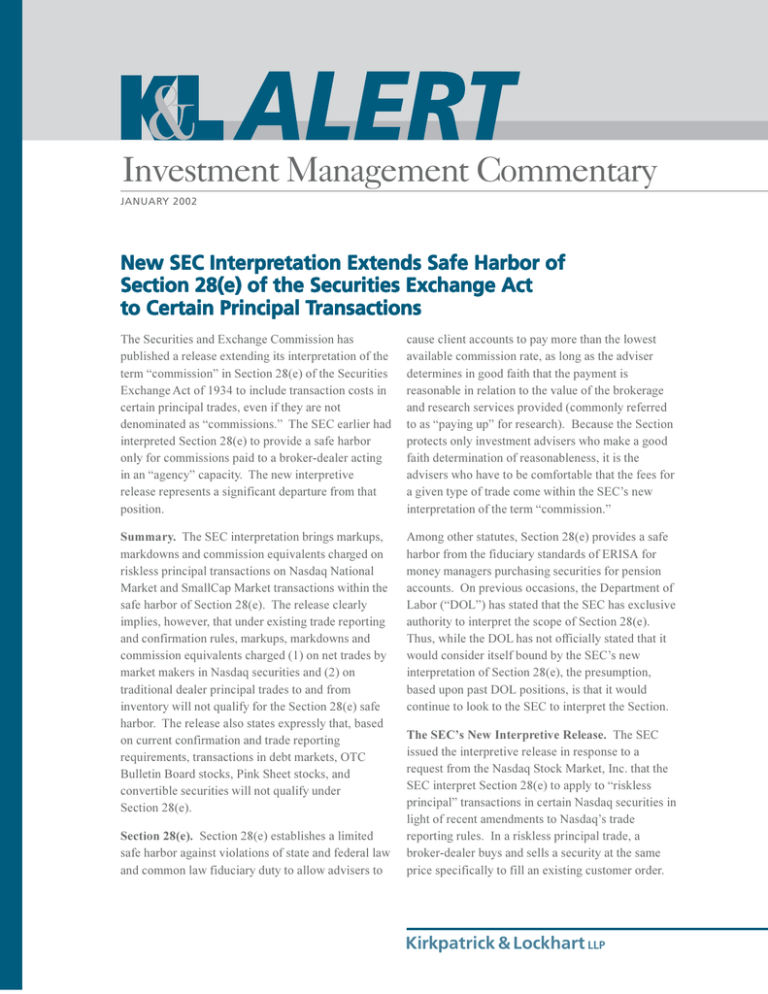
Investment Management Commentary
JANUARY 2002
New SEC Interpr
etation Extends Safe Harbor of
Interpretation
Section 28(e) of the Securities Exchange Act
to Cer
tain Principal T
ransactions
Certain
Transactions
The Securities and Exchange Commission has
published a release extending its interpretation of the
term commission in Section 28(e) of the Securities
Exchange Act of 1934 to include transaction costs in
certain principal trades, even if they are not
denominated as commissions. The SEC earlier had
interpreted Section 28(e) to provide a safe harbor
only for commissions paid to a broker-dealer acting
in an agency capacity. The new interpretive
release represents a significant departure from that
position.
cause client accounts to pay more than the lowest
available commission rate, as long as the adviser
determines in good faith that the payment is
reasonable in relation to the value of the brokerage
and research services provided (commonly referred
to as paying up for research). Because the Section
protects only investment advisers who make a good
faith determination of reasonableness, it is the
advisers who have to be comfortable that the fees for
a given type of trade come within the SECs new
interpretation of the term commission.
Summary. The SEC interpretation brings markups,
markdowns and commission equivalents charged on
riskless principal transactions on Nasdaq National
Market and SmallCap Market transactions within the
safe harbor of Section 28(e). The release clearly
implies, however, that under existing trade reporting
and confirmation rules, markups, markdowns and
commission equivalents charged (1) on net trades by
market makers in Nasdaq securities and (2) on
traditional dealer principal trades to and from
inventory will not qualify for the Section 28(e) safe
harbor. The release also states expressly that, based
on current confirmation and trade reporting
requirements, transactions in debt markets, OTC
Bulletin Board stocks, Pink Sheet stocks, and
convertible securities will not qualify under
Section 28(e).
Among other statutes, Section 28(e) provides a safe
harbor from the fiduciary standards of ERISA for
money managers purchasing securities for pension
accounts. On previous occasions, the Department of
Labor (DOL) has stated that the SEC has exclusive
authority to interpret the scope of Section 28(e).
Thus, while the DOL has not officially stated that it
would consider itself bound by the SECs new
interpretation of Section 28(e), the presumption,
based upon past DOL positions, is that it would
continue to look to the SEC to interpret the Section.
Section 28(e). Section 28(e) establishes a limited
safe harbor against violations of state and federal law
and common law fiduciary duty to allow advisers to
The SECs New Interpretive Release. The SEC
issued the interpretive release in response to a
request from the Nasdaq Stock Market, Inc. that the
SEC interpret Section 28(e) to apply to riskless
principal transactions in certain Nasdaq securities in
light of recent amendments to Nasdaqs trade
reporting rules. In a riskless principal trade, a
broker-dealer buys and sells a security at the same
price specifically to fill an existing customer order.
Kirkpatrick & Lockhart LLP
Although the broker-dealer acts as principal, it does
not bear the risk of holding the security in its
inventory. According to a recent NASD Notice
(see note 1, below), a trade is considered a riskless
principal trade only if both legs of the transaction
are executed at the same price.
The interpretation concludes that the information
money managers receive on a qualifying riskless
principal trade, and the regulatory safeguards
ensuring the accuracy of that information, provide an
adequate basis to determine the reasonableness of the
fees charged, as required by Section 28(e):
The SEC determined not to limit its interpretation to
riskless principal trades or to Nasdaq securities.
Rather, the agency interpreted the term
commission in Section 28(e) to include
Required disclosure of fees under confirmation
rules and reporting of the trade under selfregulatory organization rules at a single price
for both offsetting transactions, which provides
independent verification of this price, give
money managers information about fees and
trade prices sufficient to make the
determination of reasonableness of these
charges. It is therefore reasonable to treat such
fees as a commission for purposes of Section
28(e) only.
a markup, markdown, commission equivalent
or other fee paid by a managed account to a
dealer for executing a transaction where the fee
and transaction price are fully and separately
disclosed on the confirmation and the
transaction is reported under conditions that
provide independent and objective verification
of the transaction price subject to selfregulatory organization oversight.
The interpretation, however, cites only riskless
principal trades under NASD Rules 4632 (applicable
to Nasdaq National Market securities), 4642
(applicable to Nasdaq SmallCap Market securities),
and 6420 (applicable to eligible securities) as
examples of trades that would meet the requirements
of the new interpretation. These rules require a
riskless principal transaction in which both legs are
executed at the same price . . . to be reported once, in
the same manner as an agency transaction, exclusive
of any markup, markdown, commission equivalent,
or other fee. Thus, a money manager would pay the
same price as the dealer paid in the offsetting trade.
This price, along with the remuneration to the dealer
for effecting the transaction, is required to be
disclosed on the Rule 10b10 confirmation.
The interpretation distinguishes those qualifying
Nasdaq riskless principal trades from a dealers
traditional principal trades from inventory and a
market makers net trades.1 The release explains
that, in each of the latter trades, a dealer can receive
an undisclosed fee (i.e., compensation in the form
of its profit on the difference in prices (the spread)
between its purchase and sale of the security).2 In
addition, the release explains that the price at which
the trade is reported is to some degree within the
control of the dealer. The release thus indicates
that, because the dealer in these contexts is not
required to determine, report and confirm its trade
price and compensation in a particular way, the
money manager does not receive verifiable
information adequate to determine that the fee is
reasonable in relation to the brokerage and research
services provided.
Special NASD Notice to Members 0185 (Dec. 2001), among other things, describes a net trade, which occurs
when a market maker, at the request of a customer, while holding the customers order to buy or sell, executes an
offsetting trade on a riskless basis but at a different price. The difference between the price of the market maker s
transaction and the price of the trade with the customer is the market makers compensation. This amount generally is
not separately disclosed on the customer confirmation. Under NASD trade reporting rules, because the two transactions
are effected at different prices, the market maker must report both legs to the tape (but not to the customer).
1
A dealers profit on a principal trade is not commonly referred to as a fee in the industry. By using the term, the
interpretive release at this point may be suggesting that an unknown and unknowable portion of the dealers profit is
essentially the fee for executing the trade.
2
Kirkpatrick & Lockhart LLP
2
The SEC clearly holds out the possibility that other
categories of trades will be deemed in the future to
qualify under its new interpretive position. The
release states that, as other markets develop
regulations that ensure transparency equivalent to
that ensured by the NASD regulations, transaction
charges in those markets that meet the requirements
of the interpretation will be considered to fall within
the interpretation. The release cites the debt market
as a place where trades are not currently subject to
confirmation and reporting requirements that meet
the conditions of the new interpretation. It also cites
OTC Bulletin Board stocks, Pink Sheet stocks, and
convertible securities as examples of stocks that do
not meet the conditions of the interpretation because,
although they have similar reporting requirements,
they do not have the same confirmation requirements
for market makers.
If you have any questions or if we can assist you in any
other way, please call your regular contact at
Kirkpatrick & Lockhart LLP or one of the attorneys
listed below.
Charles R. Mills
202.778.9096 cmills@kl.com
Arthur C. Delibert 202.778.9042 adelibert@kl.com
Lori L. Schneider 202.778.9305 lschneider@kl.com
SM
Kirkpatrick & Lockhart LLP
Challenge us.
BOSTON
n
DALLAS
n
HARRISBURG
n
LOS ANGELES
n
MIAMI
n
NEWARK
n
NEW YORK
n
PITTSBURGH
n
SAN FRANCISCO
n
WASHINGTON
.........................................................................................................................................................
This publication/newsletter is for informational purposes and does not contain or convey legal advice. The information herein
should not be used or relied upon in regard to any particular facts or circumstances without first consulting with a lawyer.
© 2002 KIRKPATRICK & LOCKHART LLP.
ALL RIGHTS RESERVED.
SM

